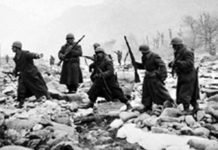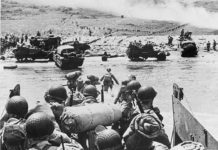Between 1865 and 1900 the United States’ Army and Navy changed in direct relation to the threats the nation faced.
The reforms the United States of America’s military made between 1865 and 1900 were adequate for the potential enemies America might face. Following the end of the Civil War the US military saw an increase in professionalization in both the Army and Navy. With this professionalization came the founding of schools for the study of strategy, as well as the genesis of general staffs for the two services. Officers graduating from the schools, and serving on the general staffs, were able to adapt the strategic and tactical goals of the Army and Navy for the conflicts they could possibly find themselves in.
Changes in the Navy
The Navy, between 1865 and 1900, resisted change under the guidance of Admiral David Dixon Porter. The US Navy shrank from its Civil War levels, but the fleet itself was not entirely stagnant. The cessation of hostilities after the Civil War allowed the Navy to begin a thorough search for overseas coaling stations which could support a naval register soon to be dominated by steam driven ships. The annual report of 1889 issued by then Secretary of the Navy, Benjamin F. Tracy, stated plainly the desire of the United States Navy for warships that were well armed, armored and, powered by steam. These warships would be of enough strength and technological prowess to fully represent the US’s growing economic and physical power.
Changes in the Army
The Army, like the Navy, found its strength being reduced, and thus began to focus upon the professionalization and preparation of its corps of officers and NCOs for any future war which might occur. The difficulty of keeping the Native Americans on Federal reservations during this period of military reform allowed the Army to train and test new strategies and tactics against dissident warriors.
Since the Federal government tasked the Army to ensure the compliance of the Native Americans with the Federal reservation system, the Army shifted from a strategy of defense to one of offense. This tremendous change in strategy allowed the Army to develop tactics that would afford small, mobile forces the ability to deliver maximum power in any given combat scenario against the fluid tactics of the Native Americans.
Neither the Army nor the Navy saw significant growth from 1865 to 1900 due to the Federal governments focus on postwar reductions. The reforms the military made during this period, however, did allow them to prepare to face the potential enemies of that time. Coaling stations in strategic locations would allow the Navy to strengthen its reach as well as effectively employ the new steamships which were under construction.
These ships, and their corresponding coaling stations, would allow the Navy to deliver troops where necessary, as seen with the deployment of troops during China’s Boxer Rebellion. The Army, in its turn, developed small unit tactics which would be effective in allowing individual commanders to mount successful and original attacks against belligerent Native American tribes who did not wish to be sent to Federal Reservations, and to conduct counterinsurgencies in the Philippines. Thus while the military found itself physically smaller, intellectually it had grown exponentially.
Sources:
- Boot, Max. The Savage Wars of Peace. New York, NY: Basic Books, 2002.
- Frank, Richard. The American Military Experience Part V. Norwich University, 2008.
- Hagan, Kenneth J. This People’s Navy, (New York, NY: The Free Press, 1992), 194.
- Linn, Brian M. “Provincial Pacification in the Philippines, 1900-1901 : The First District Department of Northern Luzon,” Military Affairs.
- Millett, Allan R. and Peter Maslowski. For the Common Defense. New York, NY: The Free Press, 1994.
- Weigley, Russell F. The American Way of War. Bloomington, IN: Indiana University Press, 1977.







